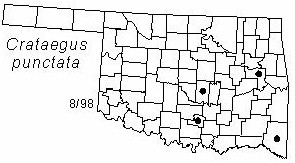Small tree to 6 m (20 ft) in height and 15 cm (6 in) in diameter. Crown rounded with spreading branches, flattened on top. Bark gray to brown and scaly. Twigs brown to gray, hairy when young, with many spines up to 6.5cm (2.5 in) long. Leaves alternate, simple, mostly obovate, 5-7.5 cm (2-3 in) long and 2-5 cm (0.8-2 in) wide, glabrous above, densely pubescent along veins beneath when young , dull green with sunken veins above, paler beneath; base, blunt or rounded at apex, margins finely serrate except at the base; petiole short, 3-4 mm (0.1 in) long. Flowers in corymbs, pubescent to nearly glabrous, numerous, 13-18 mm (0.5-0.8 in) wide, 5 in number; petals 5, white; styles 2-5; stamens 20, pink or yellow; flowers appear from April to May. Fruits pomes, 13-18 mm in diameter, oblong to subglobose in drooping clusters, dull red with whitish glands; fruits mature in autumn.
Distribution: Oklahoma, Arkansas, Missouri, north to Wisconsin east to Newfoundland, south to North Carolina. Scattered to common in Oklahoma.
Habitat: moist soil along small streams.
Comments: Crataegus is from the Greek meaning "flowering thorn"; punctata refers to the glands on the fruits.
Field identification: glands on the fruits readily distinguish this species from other hawthorns in Oklahoma. Also, the veins are impressed on the upper surface of the leaf.
Horticulture: dotted hawthorn has dense foliage and showy flowers.
Wildlife benefits: In general, the fruits of hawthorn species are eaten by several species of birds.
NWI status: none
Distribution in Oklahoma: 
BACK
NEXT
RETURN TO INDEX
Last update: 9/9/99
 Go to Oklahoma Biological Survey Home Page
Go to Oklahoma Biological Survey Home Page
 Disclaimer
Disclaimer